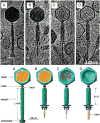Cryo-electron tomography of bacterial viruses
- PMID: 23217626
- PMCID: PMC5119483
- DOI: 10.1016/j.virol.2012.08.022
Cryo-electron tomography of bacterial viruses
Abstract
Bacteriophage particles contain both simple and complex macromolecular assemblages and machines that enable them to regulate the infection process under diverse environmental conditions with a broad range of bacterial hosts. Recent developments in cryo-electron tomography (cryo-ET) make it possible to observe the interactions of bacteriophages with their host cells under native-state conditions at unprecedented resolution and in three-dimensions. This review describes the application of cryo-ET to studies of bacteriophage attachment, genome ejection, assembly and egress. Current topics of investigation and future directions in the field are also discussed.
Copyright © 2012 Elsevier Inc. All rights reserved.
Figures




Similar articles
-
Bacteriophage-host interactions leading to genome internalization.Curr Opin Microbiol. 2011 Aug;14(4):492-6. doi: 10.1016/j.mib.2011.07.010. Epub 2011 Jul 21. Curr Opin Microbiol. 2011. PMID: 21783404 Review.
-
Bacteriophage electron microscopy.Adv Virus Res. 2012;82:1-32. doi: 10.1016/B978-0-12-394621-8.00017-0. Adv Virus Res. 2012. PMID: 22420849 Review.
-
Structure of epsilon15 bacteriophage reveals genome organization and DNA packaging/injection apparatus.Nature. 2006 Feb 2;439(7076):612-6. doi: 10.1038/nature04487. Nature. 2006. PMID: 16452981 Free PMC article.
-
The bacteriophage genome undergoes a succession of intracapsid phase transitions upon DNA ejection.J Mol Biol. 2010 Feb 19;396(2):384-95. doi: 10.1016/j.jmb.2009.11.047. Epub 2009 Nov 26. J Mol Biol. 2010. PMID: 19944702
-
Structural variability and complexity of the giant Pithovirus sibericum particle revealed by high-voltage electron cryo-tomography and energy-filtered electron cryo-microscopy.Sci Rep. 2017 Oct 16;7(1):13291. doi: 10.1038/s41598-017-13390-4. Sci Rep. 2017. PMID: 29038566 Free PMC article.
Cited by
-
Imaging Techniques for Detecting Prokaryotic Viruses in Environmental Samples.Viruses. 2021 Oct 21;13(11):2126. doi: 10.3390/v13112126. Viruses. 2021. PMID: 34834933 Free PMC article. Review.
-
Zernike phase-contrast electron cryotomography applied to marine cyanobacteria infected with cyanophages.Nat Protoc. 2014 Nov;9(11):2630-42. doi: 10.1038/nprot.2014.176. Epub 2014 Oct 16. Nat Protoc. 2014. PMID: 25321408 Free PMC article.
-
Dissecting Virus Infectious Cycles by Cryo-Electron Microscopy.PLoS Pathog. 2016 Jun 30;12(6):e1005625. doi: 10.1371/journal.ppat.1005625. eCollection 2016 Jun. PLoS Pathog. 2016. PMID: 27362353 Free PMC article. Review. No abstract available.
-
Polymorphism of DNA conformation inside the bacteriophage capsid.J Biol Phys. 2013 Mar;39(2):201-13. doi: 10.1007/s10867-013-9315-y. Epub 2013 Apr 12. J Biol Phys. 2013. PMID: 23860869 Free PMC article.
-
OmpA and OmpC are critical host factors for bacteriophage Sf6 entry in Shigella.Mol Microbiol. 2014 Apr;92(1):47-60. doi: 10.1111/mmi.12536. Epub 2014 Mar 6. Mol Microbiol. 2014. PMID: 24673644 Free PMC article.
References
-
- Agirrezabala X, Martin-Benito J, Valle M, Gonzalez JM, Valencia A, Valpuesta JM, Carrascosa JL. Structure of the connector of bacteriophage T7 at 8 A resolution: structural homologies of a basic component of a DNA translocating machinery. J Mol Biol. 2005;347:895–902. - PubMed
-
- Baumeister W. Mapping molecular landscapes inside cells. Biol Chem. 2004;385:865–872. - PubMed
-
- Baumeister W. From proteomic inventory to architecture. FEBS Lett. 2005;579:933–937. - PubMed
Publication types
MeSH terms
Substances
Grants and funding
LinkOut - more resources
Full Text Sources
Other Literature Sources

